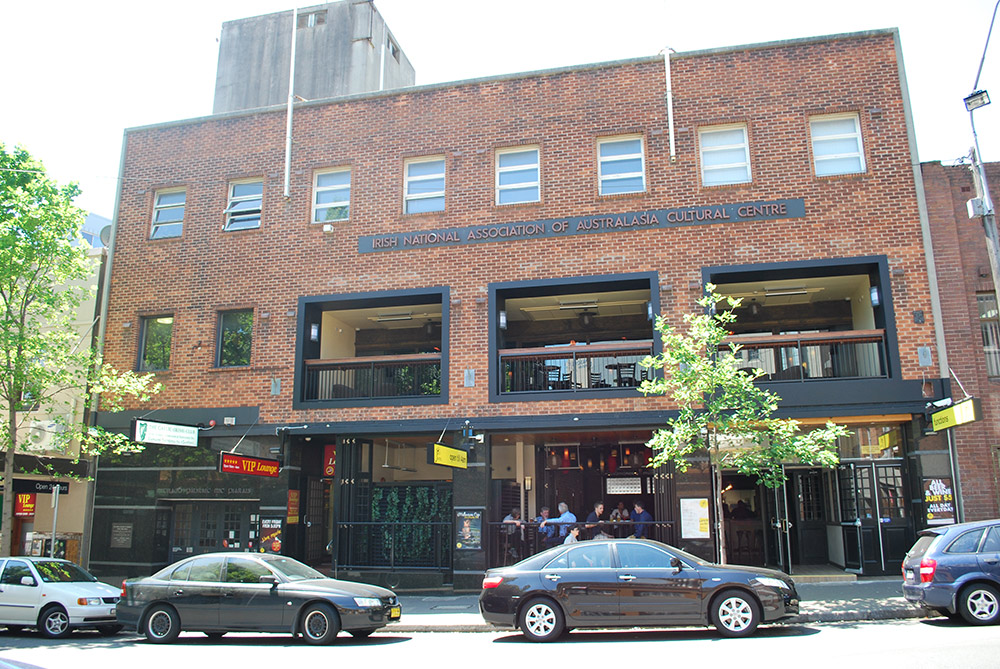
A question I didn’t expect myself grappling with heading into this project was perhaps one of the more simple ones – what is The Gaelic Club? A casual observer going there every now and again for a drink might just think of it as one of Sydney’s many Irish-themed pubs, with the added caveat of having to walk up a flight of stairs once.
The Gaelic Club is an institution and a space that is far more complex, and may be many different things, depending on whom you ask. While it’s a pub, it has one bar, a small selection of drinks, and no screens or poker machines. It does not operate for profit, and has often run at a loss. It is very consciously a place for the preservation of Irish culture, music and language in a society where that is not the default. It is also a community hub – people from young adults to the retired come for the community, to meet people and to see familiar faces. There are signs around the club advertising financial assistance for Irish in Sydney facing hardship far from family supports.
It is a home for Friday night traditional music sessions – people from across Sydney, from a range of backgrounds come down to play tunes and sing songs, and this is a key draw that has brought me to the site. Irish language lessons take place on Mondays. It is the place I’ve heard the most Irish being spoken outside of Ireland. Groups such as Sydney Queer Irish use the space as a base, and it is the home of the Irish Support Agency – despite being a small upstairs floor of a building in the city.
The building’s ground floor was sold in 2003 in the wake of issues stemming from an attempted redevelopment and contests over management. Prior to this, my understanding is that the ground floor was used as a space to hold regular Irish dances, events in which people would socialise, gather, meet partners and so forth. I’ve chatted now with quite a few people who have been around the space for a while, and a common thread is that it really was a central place for the Irish in Sydney. It was a space newly arrived people might come to find a job, to access support or make friends.
I’ve been going to the Gaelic Club for a while on and off, originally for Politics in the Pub some years ago and more recently for the traditional music sessions, so I knew a few familiar faces when I headed there last Friday night. I got chatting with a few people and got some contact details, and a project began to take shape.
I was chatting with a fella who has done some work with the Gaelic Club and the Irish National Association before, and realised after talking to him that he had created an oral history project of Irish seniors in Sydney, known as A Lifetime of Stories, linked here. It’s inspired my project, which in its formative stages is looking likely to be a compilation of audio recordings, dealing with the ways that people use the space and how that has changed through time and/or across generations.

I was president of the Gaelic Club in the early 1980s.
Maybe I could help you fill in some f its history.
Did you know a gentleman by the name of Jimmy who worked at Bradley Brothers Ltd? I can’t remember his surname name now.
I was looking for live theatre performances and came on the Gaelic Club. The address caught my attention immediately as it has to be the the same hall that I remember from the 1950s. My grandfather Patrick (Paddy) Gallagher was born in Ballyshannon, Donegal in 1889 and came to Australia in 1912. He paid for his two elder brothers Mick and Joe to come here in the following two years. They both settled in Queensland and became cane farmers in the Innisfail area. Paddy remained in Sydney managing wine saloons ( I think they were called) for Tooth and Co for many years in the Haymarket and after that, thirty years as a labourer at Mungo Scotts flour mill in Summer Hill. His home at 33 Edward Street Summer Hill (where my parents and our family also lived) was a regular meeting place for INA members. They would socialise and play cards etc. The upper storey was a boarding house with a number of rooms which were mostly occupied by single Irishmen whom my grandmother Katherine cooked and laundered for like they were her own children. I knew a little Gaelic when I was young but it is long since gone. I was very, very close to my grandfather and I recall Devonshire Street as the place he used to take me to INA meetings with him. I vividly remember one meeting, probably in 58 or 59 where some very excitable gents did a bit more than converse. I also remember the lounge room at Edward Street also had some excitable moments. Just thought these memories might be of some interest you.
PS
We live in Murwillumbah but Sylvia and I are visiting Sydney soon and will be sure to pop into the Gaelic Club.
I am a past manager, president and treasurer of the Gaelic Club (2010s), past secretary, warden and librarian of the INA, (2002-2018). Since 1997, I have been teaching the Irish language at the Gaelic Club on behalf of the INA, Conradh na Gaeilge, and now, the Irish Language School, Sydney. I can certainly help you with a lot of the details of the history of the Association, the Club, the language school and dancing schools – especially over the past 25 years (but also the early years, too.)